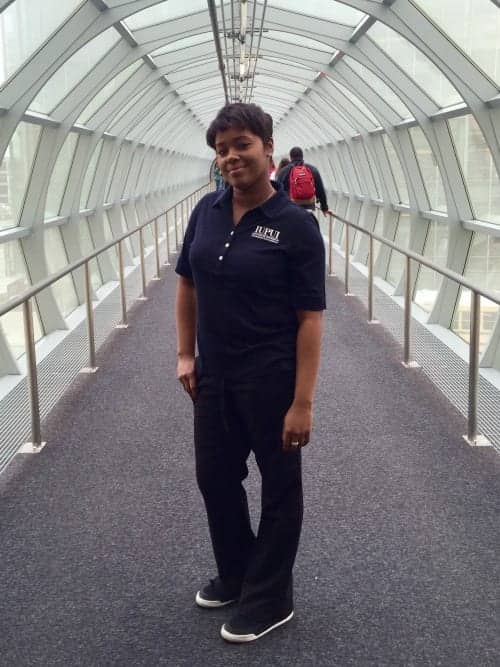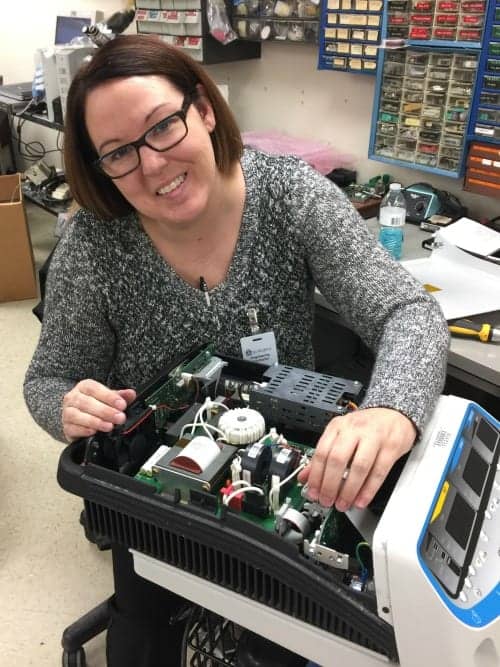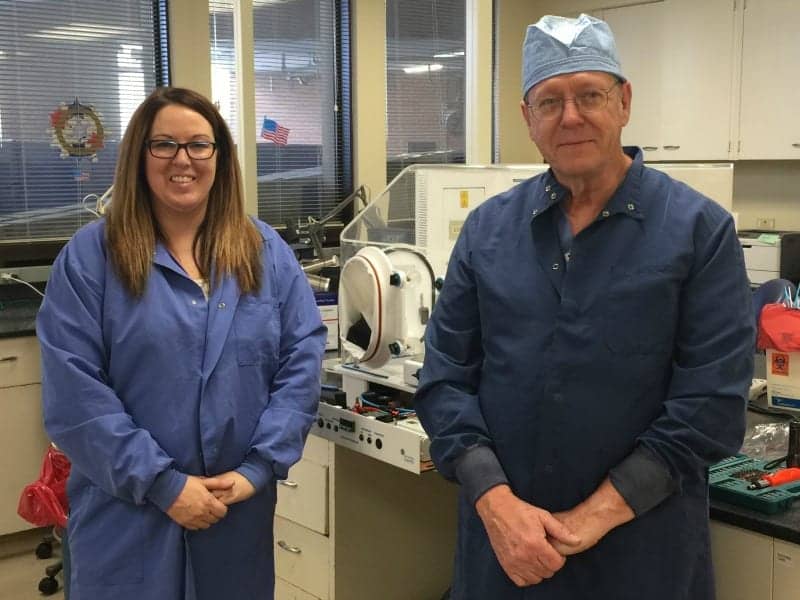Tomorrow’s technicians are creative, driven, resourceful—and more diverse than their predecessors
Nicca Louis fell into the healthcare technology management (HTM) field somewhat by chance.
The 27-year-old Brooklyn native originally received her GED while taking classes for an associate’s degree to be a medical office assistant. Afterward, she decided to do some traveling. On a trip to Las Vegas, she met a woman in town for a biomedical conference, and once they got talking, the field piqued Louis’ interest.
After doing some research, she enrolled in a biomedical engineering program at DeVry University in New York City. While there, she researched schools that had solid programs in technology and engineering, and she eventually landed in the biomedical engineering technology program at Indiana University—Purdue University Indianapolis (IUPUI), where she recently earned the program’s Indiana Biomedical Society Philomena Diehl Memorial Scholarship.
Louis is part of a new group of biomeds soon to enter the field at a time when it’s in a great deal of flux. Workers in the Baby Boomer generation will retire en masse in coming years, leading to a shortage of qualified biomeds, as 24×7 reported in the 2015 salary survey. Younger, soon-to-be technicians who are now graduating from school will be crucial for the future of the industry.
Louis currently has an internship at Riley Hospital for Children at Indiana University Health, and plans to graduate in May. Through her work there so far, she notices the sea change happening in the field as senior professionals move on.
“I think their way of thinking and doing things is a lot different from what I know,” she says of the older and more experienced workers with whom she interacts. “They do things their own way…But I learn from them, I learn a ton from them.”
Under the Radar
Joey Jones, CBET, is a professor in studies of healthcare technology management and biomedical technology systems at Madisonville Community College in Madisonville, Ky. He says that many of his best students are slightly older than typical college-age students, and it’s still a significant challenge to recruit students from high school to get into the biomed field. He has just four students graduating this May.
At the crux of that problem?
“The big issue is people just don’t know about this field,” Jones says. “We grow up knowing about doctors and nurses, but no one knows about biomedical equipment technicians.”
But that also means that when some students stumble upon HTM unexpectedly, they find exactly what they didn’t know they were looking for. That’s reflective of Louis’ experience, happening upon a field she had never heard about on the suggestion of a stranger.
Erin Mangum, 23, also tried several other fields before landing in the biomed program at IUPUI.
She originally started at the campus as a biology major. She knew she was interested in science but felt more uncertain about the chemistry side. So, she went to her guidance counselor and asked if the school had a program available that would work better for her interests. That’s how she discovered HTM.
“It’s a weird place to find a calling because it’s like this little nook,” says Mangum, who grew up in Indiana and plans to graduate in August with her associate’s degree. The field combines several different types of technology, engineering, and science into one discipline.
And as for being a young person in Biomed, Mangum feels like she definitely made the right choice after watching many of her friends go to college for less marketable degrees. She says that many of them were “super-excelling” and graduated in fewer than 4 years from college, studying disciplines such as anthropology or languages.
“But now, none of them can get jobs,” she says. She feels a great deal more job security in her path. “Everyone I talked to genuinely enjoys [Biomed] … And it’s in high demand, because there’s always going to be medical equipment. It’s always going to break.”
Jennifer Albright, 37, is a student in the HTM program taught by Jones at Madisonville Community College. She says she long wanted to return to school after receiving her GED, then having kids and working other jobs, but was held back partly because she wasn’t sure what she wanted to study.
Before entering the program, she worked jobs at a shoe store and a bank, among others, and saw many of her friends go off to nursing school or graduate from other programs. After doing research to figure out how to channel her interests, she landed on HTM.
“I always knew I wanted to go to school, and always wanted to do something in the health field,” says Albright, who is originally from Marion, Ky, and has two teenage children.
She started looking through the community college website. The HTM program seemed to mention a lot of things that interested her, so she followed up by talking to an instructor and ended up enrolling.
For Albright and many others, Biomed is a good fit for because it allows workers to help patients, without treating them physically.
“I was intrigued by how the body works,” she says. “However, I didn’t want any patient care—I didn’t want to deal with the blood and all that. With this, I’m helping people by maintaining the equipment and making sure it’s safe.”
Louis had the same mentality. “I thought this would be a great way to help patients without physically helping patients.”
Wanted: Hands-on Mentors
But as much promise as the field holds, Albright says that as someone who’s about to enter the biomed profession, she’s worried about the chunk of workers who will soon retire—a large group, starting around 2020—and thinks there aren’t going to be enough people graduating into the field to fill that hole.
“It’s kind of scary, I guess, in a way,” Albright says. “There’s so much knowledge in the senior biomeds. I’m just hoping that where I land in my career, there’s going to be someone to help me grow.”
Albright is currently interning at St. Mary’s Medical Center in Evansville, Ind, under Jerry Schauss, who recently earned the Indiana Biomedical Society’s Professional of the Year Award. She says that her work with Schauss has been a great learning experience, and that he helps her bridge the gap between what she’s learned in the classroom and using that information on the job. But it’s also highlighted her worries about the aging field.
“The internship hasn’t really addressed my concerns on workers about to retire,” Albright says. “It actually concerns me more. When Jerry leaves, there will be a huge hole in the shop.”
As a result of experiencing how hard it can be to find hands-on mentors in the field, Louis decided to spearhead a biomed conference for students with the help of the Indiana Biomedical Society. The goal is to hold an event in September that includes a career fair, teachers, and vendors available to answer questions, along with people to help with mock interviews and resume building.
“A lot of us students need that. We don’t get the guidance from beginning to end,” Louis says. For many students, developing personal and professional relationships with older biomeds just depends on keeping in contact. Such an arrangement offers benefits for mentors, too: Those who have been in the field a longer time or retired out can learn about what’s new and changing.
Mangum’s approach to making sure she finds mentorship is to be aggressively proactive. She’s heard from other professionals that having an extroverted personality helps when it comes to excelling in internships or at work. For junior professionals, that means showing you’re engaged and being inquisitive.
“If you get into a shop where it’s an older group and you’re kind of a young pup, they might not want you to bother them,” she says. “They’re not going to neglect you, but I think if you’re more active about asking questions, pursuing them about more things to do—if they know you’re interested, they get interested.”
Unfazed by IT
For many younger professionals entering the field, what they learn in school and on the job will diverge from the skills acquired by their predecessors. There’s more of an emphasis now on information technology (IT) than in the past. That trend may place some younger workers at an advantage, even if it will be harder for them to acquire on-the-job mentorship as experienced workers retire.
Jones says that the IT change has been hugely noticeable. The profession “had an industrial core, and now it has an IT core,” he says. “I saw that shift happening.”
In the classroom, he will occasionally see older students struggle with the IT side of the work. Some might be more comfortable with the technology if they have kids who have already exposed them to using things like smartphones, which have even become a tool in the classroom.
Mangum constantly hears about the rising importance of IT at industry conferences, where networking workshops and training are offered.
“The idea with this degree is, you’re always going to have to pursue education. You pick up a new thing, learn a new format, and move forward,” she says. That fits well with the mindset of the industry, she says, which draws people who like to tinker.
“Even if someone doesn’t understand all the technicalities, they can troubleshoot the software.”
Mangum developed the “tinker” mindset early on. When she was younger, she removed all the screws from her family’s dining room table and chairs, but left everything standing perfectly upright. It wasn’t until everyone sat down and the furniture collapsed that they realized what she’d done.
Dodging Stereotypes
As women, all of these students also come from the minority in the biomed field. Women made up just 8% of the respondents to 24×7’s annual survey of workers in the sector last year.
Mangum says that when she started in her program at IUPUI, she was the only woman. Now, there are around five, but she’s also been told by seasoned technicians at biomed conferences that the profession “will be an uphill battle as a woman.”

Louis on the IUPUI campus. She says she’s determined to overcome any stereotypes associated with being female and African American in a male-dominated field.
Louis is set on making sure any stereotypes within the field don’t block her from opportunity. She’s aware that in a male-dominated field, her gender could lead some colleagues to assume, “ ‘Oh she’s a female, she doesn’t know her stuff.’ And I’m African American—that plays a part too,” Louis says. “But I just want to be able to overcome that. I want those opportunities and chances just as much as a Caucasian white older man.”
And younger people are changing the field in many ways. Jones says that the younger workforce is usually more socially interactive—an attribute especially needed today because the industry has become less siloed.
“Biomed is not working in the shop like it was 20 or 30 years ago, working on circuit boards,” he says. “You’re out mingling, you’re dealing with various departments. This younger population has the social skills to work with other departments. I think they’re more in tune with working with others than the older generation, which is more about working by themselves in the shop.”
But even though this fresh crop of workers brings certain advantages, recruiting and retaining talent will continue to be a challenge for the field. Jones says that’s partly why he tries to make sure that one of the key things people learn about the industry as they’re choosing a career path is the variety in Biomed.
“You’ve got to know a little bit of everything…There’s no way you can get bored—there’s too much to learn,” he says.
Students study an array of disciplines, including electricity, electronics, refrigeration, pneumatics, hydraulics, physics, chemistry, medical terminology, anatomy, and physiology.
“It’s a lot,” he says, “and that’s what makes this field exciting.”
A.J. Zak is a contributing writer for 24×7. For more information, contact chief editor Jenny Lower at [email protected].









More women are needed, it’s a great field to in.
Great article! Value your mentors. I am still young but I have witnessed the industry go from component level repair to board swapping. Much of what I learned came from my older mentors.
I’ve been in the industry for 19 years and we definitely need more women in the field. I have 5 female biomed techs on my team that are part of a very diverse team of 19 total. It’s great to hear about people up for the challenge of becoming a biomed. We need to reach out to the high schoolers, the undecided college student and those looking for a career change about HTM. This is truly a great field to be in!
I’m not sure what ethnicity has to do with anything in the biomedical field, I’ve never seen anyone get turned down for biomed due to their skin color. I think the only thing that challenges and hinders us in the biomed field is bad mentalities. I’m a woman, I’ve worked with males, Hispanic, African American, Caucasian, Asian and a few women here and there, but the women never really seem to stick around.
I’ve done this for 12 years and I enjoy it, it’s hard sometimes but the men are very supportive sometimes, but not all the time.
I think people make a big deal of who is in the field, gender wise and personally I don’t care, if you can do the job, come on down the field can ALWAYS use the help, but like everything else bring your “A” game and not biased attitudes, we have enough attitudes in the field, we just want people who are willing to pick up their screwdrivers and do the job. If you can fit that role then do it.